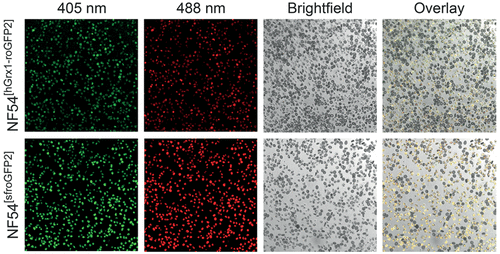当前位置:
X-MOL 学术
›
ACS Infect. Dis.
›
论文详情
Our official English website, www.x-mol.net, welcomes your
feedback! (Note: you will need to create a separate account there.)
Stable Integration and Comparison of hGrx1-roGFP2 and sfroGFP2 Redox Probes in the Malaria Parasite Plasmodium falciparum
ACS Infectious Diseases ( IF 4.0 ) Pub Date : 2018-08-21 00:00:00 , DOI: 10.1021/acsinfecdis.8b00140 Anna Katharina Schuh 1 , Mahsa Rahbari 1 , Kim C. Heimsch 1 , Franziska Mohring 1 , Stanislaw J. Gabryszewski , Stine Weder 1 , Kathrin Buchholz 1 , Stefan Rahlfs 1 , David A. Fidock , Katja Becker 1
ACS Infectious Diseases ( IF 4.0 ) Pub Date : 2018-08-21 00:00:00 , DOI: 10.1021/acsinfecdis.8b00140 Anna Katharina Schuh 1 , Mahsa Rahbari 1 , Kim C. Heimsch 1 , Franziska Mohring 1 , Stanislaw J. Gabryszewski , Stine Weder 1 , Kathrin Buchholz 1 , Stefan Rahlfs 1 , David A. Fidock , Katja Becker 1
Affiliation

|
Studying redox metabolism in malaria parasites is of great interest for understanding parasite biology, parasite–host interactions, and mechanisms of drug action. Genetically encoded fluorescent redox sensors have recently been described as powerful tools for determining the glutathione-dependent redox potential in living parasites. In the present study, we genomically integrated and expressed the ratiometric redox sensors hGrx1-roGFP2 (human glutaredoxin 1 fused to reduction–oxidation sensitive green fluorescent protein) and sfroGFP2 (superfolder roGFP2) in the cytosol of NF54-attB blood-stage Plasmodium falciparum parasites. Both sensors were evaluated in vitro and in cell culture with regard to their fluorescence properties and reactivity. As genomic integration allows for the stable expression of redox sensors in parasites, we systematically compared single live-cell imaging with plate reader detection. For these comparisons, short-term effects of redox-active compounds were analyzed along with mid- and long-term effects of selected antimalarial agents. Of note, the single components of the redox probes themselves did not influence the redox balance of the parasites. Our analyses revealed comparable results for both the hGrx1-roGFP2 and sfroGFP2 probes, with sfroGFP2 exhibiting a more pronounced fluorescence intensity in cellulo. Accordingly, the sfroGFP2 probe was employed to monitor the fluorescence signals throughout the parasites’ asexual life cycle. Through the use of stable genomic integration, we demonstrate a means of overcoming the limitations of transient transfection, allowing more detailed in-cell studies as well as high-throughput analyses using plate reader-based approaches.
中文翻译:

hGrx1-roGFP2和sfroGFP2氧化还原探针在疟原虫恶性疟原虫中的稳定整合和比较
研究疟疾寄生虫中的氧化还原代谢对于理解寄生虫生物学,寄生虫与宿主之间的相互作用以及药物作用机制具有极大的兴趣。遗传编码的荧光氧化还原传感器最近已被描述为确定活寄生虫中谷胱甘肽依赖性氧化还原电位的强大工具。在本研究中,我们通过基因组学方法整合并表达了比例氧化还原传感器hGrx1-roGFP2(与还原-氧化敏感的绿色荧光蛋白融合的人谷胱甘肽1)和sfroGFP2(超级文件夹roGFP2)在NF54 - attB血期恶性疟原虫寄生虫的细胞质中。两种传感器均经过体外评估以及在细胞培养中的荧光特性和反应性。由于基因组整合可以使氧化还原传感器在寄生虫中稳定表达,因此我们系统地比较了单个活细胞成像与酶标仪的检测。为了进行这些比较,分析了氧化还原活性化合物的短期作用以及所选抗疟药的中长期作用。值得注意的是,氧化还原探针的单一成分本身并不影响寄生虫的氧化还原平衡。我们的分析显示两个比较的结果的hGrx1-roGFP2和sfroGFP2探针,与sfroGFP2表现出更明显的荧光强度在纤维素的。因此,sfroGFP2探针用于监测整个寄生虫无性生命周期的荧光信号。通过使用稳定的基因组整合,我们展示了一种克服瞬时转染局限性的方法,允许使用基于读板器的方法进行更详细的细胞内研究以及高通量分析。
更新日期:2018-08-21
中文翻译:

hGrx1-roGFP2和sfroGFP2氧化还原探针在疟原虫恶性疟原虫中的稳定整合和比较
研究疟疾寄生虫中的氧化还原代谢对于理解寄生虫生物学,寄生虫与宿主之间的相互作用以及药物作用机制具有极大的兴趣。遗传编码的荧光氧化还原传感器最近已被描述为确定活寄生虫中谷胱甘肽依赖性氧化还原电位的强大工具。在本研究中,我们通过基因组学方法整合并表达了比例氧化还原传感器hGrx1-roGFP2(与还原-氧化敏感的绿色荧光蛋白融合的人谷胱甘肽1)和sfroGFP2(超级文件夹roGFP2)在NF54 - attB血期恶性疟原虫寄生虫的细胞质中。两种传感器均经过体外评估以及在细胞培养中的荧光特性和反应性。由于基因组整合可以使氧化还原传感器在寄生虫中稳定表达,因此我们系统地比较了单个活细胞成像与酶标仪的检测。为了进行这些比较,分析了氧化还原活性化合物的短期作用以及所选抗疟药的中长期作用。值得注意的是,氧化还原探针的单一成分本身并不影响寄生虫的氧化还原平衡。我们的分析显示两个比较的结果的hGrx1-roGFP2和sfroGFP2探针,与sfroGFP2表现出更明显的荧光强度在纤维素的。因此,sfroGFP2探针用于监测整个寄生虫无性生命周期的荧光信号。通过使用稳定的基因组整合,我们展示了一种克服瞬时转染局限性的方法,允许使用基于读板器的方法进行更详细的细胞内研究以及高通量分析。











































 京公网安备 11010802027423号
京公网安备 11010802027423号